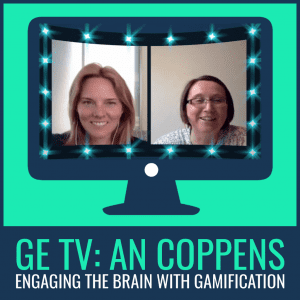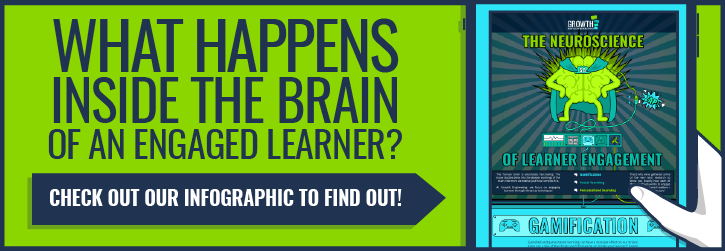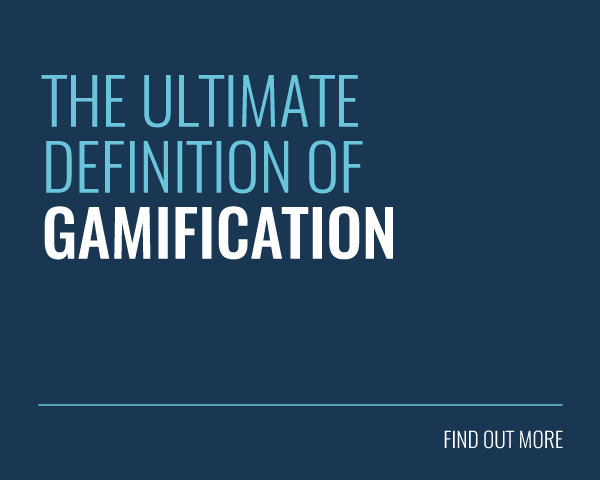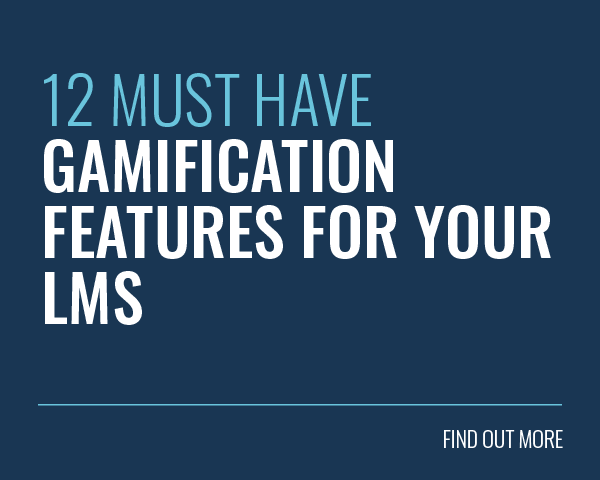 Welcome to a brand new episode of GE TV! This week we’re joined by An Coppens, the Chief Game Changer at Gamification Nation.
Welcome to a brand new episode of GE TV! This week we’re joined by An Coppens, the Chief Game Changer at Gamification Nation.
At Gamification Nation, An offers gamification design services, gamification membership communities, and online learning programmes.
As if that wouldn’t keep her busy enough, she’s also an award-winning business coach, learning and development professional, author of multiple books, and globe-trotting speaker!
Watch this interview to find out:
- How gamification helps the brain learn
- The most powerful ways to apply gamification to learning
- What makes a great learning game
- Using adaptive learning to personalise the learner experience
- Weaving narrative and Epic Meaning into learning
- What the future holds for gamified learning
Check below the video for a full transcript. (And excuse the GE Puppy howling in the background. She heard the name ‘An Coppens’ and couldn’t contain her excitement!)
[vc_video link=”https://www.youtube.com/watch?v=OInQqsVbheg”]
[vc_tta_accordion toggle=”1″]
[vc_tta_section title=”Full interview transcript” icon=””]
(0:00) Hello and welcome to GE TV! Today we’re joined by An Coppens, who has one of the best job titles I’ve ever come across. She is the Chief Game Changer at Gamification Nation, where she offers gamification design services, gamification membership communities, and online learning programmes.
As if that wouldn’t keep her busy enough, she’s also an award-winning business coach, learning and development professional, author of multiple books, and globe-trotting speaker.
An, it’s an absolute honour to have you joining us at GE TV!
Thank you very much, and thank you very much for inviting me. I follow your progress and the team’s progress with interest, because you have some great tools available, so I’m always looking to see what you guys are doing!
(1:05) Fantastic! Let’s jump right in, because I’m sure everybody is eagerly awaiting what you have to say.
The first question we’ve got for you is this. You trained as a neuroscientist before coming into L&D. Could you tell us a little bit about how gamification helps the brain learn?
The way our brain makes sense of information is that we need stimulus in our brain to make connections, and the connections are what make us remember information. The stimulus can come from games.
If you have the ideal state for learning, you’re somewhere between alert and relaxed. If you’re in game-playing mode, you’re usually in that relaxed/alert state where you’re open to taking in new stimuli, and you’re also open to building new connections.
What games and gamification do very well is encourage us to attach that new information to information that we have already, and to create new connections and applications. ‘Oh, I didn’t know I could use that there. Oh, that’s new, I’ll explore that.’
The more you can build on old information and make new connections, the better it will stick. And it will also encourage information-seeking, to go further and look for more information.
Then if we have game mechanics which keep the attention span high, as well as the positive reinforcement of what we’ve taken in (saying ‘hey, great job, you’re doing fantastically’), it keeps us wanting to do more.
Part of it is neuroscience, part of it is also how we learned as children. If you think about the first things you learned, it was usually a parent at the other side of the room encouraging you to stand up and walk. You fall over but they helped you up and encouraged you to go again.
That’s how we’ve traditionally been conditioned to learn, and it’s very much along a similar line to how we learn in our brain. Our brain gets lots of information, but only selects that which it considered relevant and interesting to build on.
Gamification can show ‘this is relevant, you need more of this’. Or it can build it into a challenge to help you pick up certain parts. Otherwise, the brain would ignore it and say ‘hey, that’s not so important’.
It’s always good to mix old and new information. And it’s always good to reinforce the positives, and give that tension where you always feel that there’s an element of being comfortable and knowing something, but also an element of being stretched and wanting to know something.
That’s the concept of ‘flow’, which I’m sure you’ve heard of before. It’s when you’re in an ideal state where you’re being stretched a little but are okay in the level of skills needed to stretch further.
The more we can change the connections we have, or build on the connections that we don’t yet have, the better and more structured our learning will be.
If you look at an expert’s brain, their networks of connections are a lot closer. If you look at a novice’s brain, it will be a lot less structured. And the amount of information you can take in as a novice is a lot smaller than the information you can take in as an expert. Because the expert’s brain automatically scans for what’s important, whereas the novice is still learning and still making sense.
So providing meaning is absolutely essential to make sense of anything.
(5:27) That was really interesting! In terms of applying gamification, what are some of the best or most powerful ways you’ve seen to apply gamification to learning?
I think the most interesting, or most useful way, is to apply an element of curiosity. Something that makes me want to see what’s there and work out how I get there.
You create either a quest or an adventure, a way for me to explore something new that is of interest to me. It could even be a flashing something on the screen that makes me want to get there.
And then if I find that the first occasion is interesting, I’ll go looking for more. How you attract people to the first level is always the biggest thing, because that’s where you first get them engaged. If you then have further stretches and challenges at my level, I would like to continue.
If on that first level I don’t play to curiosity, I don’t play to the element of wanting to learn more, you have probably lost your chance with a lot of learners.
The key is starting up on a high.
Then the other gamification mechanics I see a lot, which I think are good, are progression elements. You level up, or see your coin score, or simple progression bar. These can be helpful.
Progression bars become more helpful once people are over halfway, rather than before then. It’s just mentally that we’re trying to get past the halfway point, because otherwise we feel like we’re still at the beginning.
If you have that trajectory, the progression bar only adds value over a certain percentage, over halfway I think.
One of the things I absolutely love is getting rewards for meaningful activities. Those rewards can be virtual coins. I don’t mean everybody should get more money, because I get asked that a lot in the corporate sector. ‘Do we need to spend money on this?’ No!
Even virtual coins that may unlock more parts of learning or more parts of your system, I think it’s a very creative way of making learners say ‘as the learner, I actually want to learn more of this’.
From the feedback perspective, and especially if you’re in the corporate environment where you’re in the learning and development team, a very useful technique is to have your material rated by the users. They give you a 1-5 star rating, like you see on Amazon, but for your learning. And they can say ‘that was super useful’.
You as a learning team also learn. ‘That’s more of the content we want to give.’
Personally, I’m always a bit dubious about leaderboards, but that’s a very personal opinion. I’m often asked whether we should introduce competition into learning. In a sales environment, absolutely 100% yes. In other parts of the organisation, maybe not.
With that I mean relative leaderboards showing how you’re doing against other participants. Okay, but actually putting that competitive element all the way through may not always be what you want, because then you encourage things like clicking through something quickly in order to get it done, rather than actually taking the learning on board.
This is something I’m working on quite a bit. I usually have debates with providers, but we need three levels of gamification in terms of design.
The first level is the attraction strategy. How do we get them involved, how do we get them started?
The second part is what can the system provide?
And the third level is what’s the evidence of you actually applying your learning to anything else?
In the first level you want to be the first learner who takes charge of their own learning. In the second level you get a system to give you feedback. And in the third level you apply what you’ve learned in your everyday job, and you get feedback.
That was very interesting. A lot of the mechanics you talked about then we’ve got built within our LMS.
(10:40) But I’d be really interested to understand, besides gamification, what do you think makes a really great learning game? What types of things have you seen in the content, as opposed to the platform side of things?
As long as content is scenario-based and close to real life, it tends to work very well. I’ve seen some work, I don’t know if you’ve come across them, they have an instructional design platform, ITY Studio.
What they provide is immediate scenario-based setup of your instructional learning content. I think that’s essential, when you as a learner decide you want to go here, you want to go there, you want to learn those things.
So they provide you an environment. The more it can be first-person based, the better. Less instructional, like ‘you do this here, and that there’. Let people learn by experience. By creating that experience online and in a simulated fashion, or with choice boxes where you have to make your own choice and based on that choice, you get different endings.
This is how we’ve learned in the past. How did we learn that we shouldn’t put our hand on a heated plate? Well, we put it on it and learned that, ouch, that hurts!
It’s the same idea with corporate knowledge. Let them play with it and then give them feedback about how well they did compared to peers, but also on whether they’re within the legal limits of what’s acceptable.
I did this in a classroom setting with people looking at fraud and dealing with very bad publicity. The solutions people came up with to solve, let’s say an oil spill and it’s your company’s business to deal in oil. How do you handle that?
It happened, so you can’t backtrack from the act. But how you handle it does actually still have options. By discussing different scenarios, people learn at another level. Again, you’re giving them the opportunity to make sense of it, you’ve giving them very relevant context where it can be applied to the job.
For some of them it was very real, and for other things it was maybe a bit far away, but they could see how it played out. So it made people think.
That’s the objective of learning – making people think and then making reason. ‘If that happened I would react in this way.’
Some of the game-based learning I’ve seen that have worked are very repetitive. Repetitive for a good reason, because they have to learn facts. It works as long as the facts are easy to remember and in short, snippet size.
There’s different solutions for reaching the same kind of efficiency.
(14:10) Interesting. In your book, ‘Gamification in Business’, you talk a little bit about adaptive learning. How does adaptive learning allow us to use gamification to personalise the learner experience?
At the beginning you set a challenge to judge where someone is at in terms of skills level. Then it applies the next learning piece to your level of learning.
If you’re levelling up, you might want to do a base test to find out where you should start. The base test then decides that you should start at Level 1, but others may skip all the way to Level 5 because they’ve got the basics covered. The whole idea is to find out where people are.
In language learning this has been tested quite extensively. In some areas people will perform very highly, in vocabulary for example. But that may not mean that they do super well in grammar. They may actually have different levels.
So what you joined on one thing may not be exactly how you do the next. Have a starter game to test where people are at, then build up on the levels and reward accordingly.
For someone that’s at Level 1 and getting to grips with the basics, they still deserve the rewards. Whereas Levels 5 and 6 may have more difficult scenarios, but also need a reward.
Interesting. We’ve got some functionality like that on the LMS, and we’re beginning to build that functionality out on our game-based authoring tool as well. And we’ve definitely found that learners much prefer getting a custom content delivery, so that they’re not re-doing learning they’ve already done.
(16:28) So, how important is narrative and Epic Meaning in a gamified learning solution?
It’s great to have it in it. It adds an element of context to the whole learning experience. In our brains we always want to search for meaning and context. If I can hook my learning onto something that makes sense to me and is a story, I’ll remember it for a long longer than information presented to me in a factual manner.
Most of us have learned fairy tales in our day, and those are things that we remember. We don’t necessarily know the facts behind it. We all remember the story of Little Red Riding Hood. We don’t remember that 70% of the wolf’s viciousness made her scared.
The more we can apply stories into it. It’s how tribes passed on knowledge throughout the years. It’s all to do with how we connect information to what we already know in our brains. Stories let us connect it easier, and form connections that are building on top of other things that are familiar.
Again, it’s structuring that journey to learn more in an interesting way. And who doesn’t love a good story?
We’ve definitely found the Epic Meaning element is really critical when we’re rolling out our learning platform.
If you can tie that Epic Meaning into the mission of the company, and you can connect the two, there’s a really important inter-connected piece in the mind of the learner. With regards to the values of the company, what the company stands for, and how together the individual and the organisation is going to get stronger, from this idea of touching the Epic Meaning.
There’s a sort of longevity in being able to extend the brand, it’s very pervasive. Especially when you think about how often learning touches every single individual in the organisation, while many corporate communications don’t have a way of touching every individual.
You’re absolutely right. The more you can connect it with what’s already living in the organisation, the better.
If you have an iconic figure. If I was talking about Virgin for example, a Richard Branson, adventurous-style narrative would work super well. Because people can connect with it. They already have that fun-loving spirit, so It’s only natural that learning should follow the same pattern.
So yes, I absolutely agree. It’s essential and it definitely drives the values of the company so much further. And it’s a pity I think that a lot of organisations haven’t yet discovered that, which is why it’s so popular right now, that’s why it’s so much in demand to have much more knowledge that can actually really deeply integrate into the psyche of the company and extend the brand big-time.
(20:25) Very interesting. What is the future of gamification in learning? You recently mentioned that there will be a lot more focus on social. Could you expand on that?
We’ve always learned socially, but talking, referring what we think, looking for advice. That is still one of the ways that most of us do our sense making.
Most old systems didn’t provide for that. Online learning has come to the point now where you actually can.
And we can go a level further and have a conversation completely in the virtual world, which was not possible ten years ago, at least not to the same extent as it is used now in business.
The tools are here to do it from anywhere, anytime. That sense making is what we want. Social connections, learning from others with more experience, and sharing that experience as you’re going through the course, is what allows us as adults to make sense of the context, and make sense of the actual learning.
So it’s making it relevant to me. And I will always refer to my peers. ‘As a peer, do you consider this good? If you consider this good, I respect you, so therefore I will give it credibility too.’
Whereas if somebody I respect says they’re not into this, I won’t spend too much time on it. Social has a very large impact on most of the things that we do. It’s only natural that it goes into learning.
(22:15) It’s no surprise that we absolutely love your approach to learning, An. It’s been really amazing to speak to you today! Thank you so much for your time.
Before we leave, where can people find out a bit more about you and what you do?
They can find me on Gamification Nation where I blog three times a week. So there should always be something of interest. Mondays it’s game mechanics, Wednesdays it’s things we love, like Growth Engineering for example, and Fridays it’s the feminine viewpoint on gamification, which is my flavour on whatever I come across at the time, and also occasionally about genders and how they’re motivated slightly differently.
It can be a bit of mix on the Friday, but Mondays and Wednesdays are steady!
Fantastic, that’s great! We will certainly put a link to your website on the show description.
Again An, thank you so much! We’ve known you for many years now and it really is always a delight to speak to you. You’ve got incredible insight into gamification and game-based learning, and we absolutely love all the things you do and follow your blog, so thank you very much.
[/vc_tta_section]
[/vc_tta_accordion]
Be sure to check our An’s website, and keep an eye out for plenty more GE TV interviews in the coming weeks!









